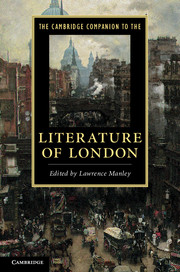Book contents
- Frontmatter
- Introduction
- 1 Images of London in medieval English literature
- 2 London and the early modern stage
- 3 London and the early modern book
- 4 London and poetry to 1750
- 5 Staging London in the Restoration and eighteenth century
- 6 London and narration in the long eighteenth century
- 7 London and nineteenth-century poetry
- 8 London in the Victorian novel
- 9 London in Victorian visual culture
- 10 London in poetry since 1900
- 11 London and modern prose, 1900-1950
- 12 Immigration and postwar London literature
- 13 Writing London in the twenty-first century
- 14 Inner London
- Guide to further reading
- Index
1 - Images of London in medieval English literature
Published online by Cambridge University Press: 28 September 2011
- Frontmatter
- Introduction
- 1 Images of London in medieval English literature
- 2 London and the early modern stage
- 3 London and the early modern book
- 4 London and poetry to 1750
- 5 Staging London in the Restoration and eighteenth century
- 6 London and narration in the long eighteenth century
- 7 London and nineteenth-century poetry
- 8 London in the Victorian novel
- 9 London in Victorian visual culture
- 10 London in poetry since 1900
- 11 London and modern prose, 1900-1950
- 12 Immigration and postwar London literature
- 13 Writing London in the twenty-first century
- 14 Inner London
- Guide to further reading
- Index
Summary
'London, thou art of townes A per se'. So, around 1500, an unknown Scots poet - the poem was long confidently ascribed to William Dunbar - begins his encomium to the greatest town he knew. The poem continues in the laudatory vein struck in its opening line for seven 'Monk's stanzas'; each ends with a refrain emphasising a superlativeness not just urban, but imperial: 'London, thou art the flour of Cities all.' 'Monk's stanza' is one of those forms invented in English by medieval London's greatest poet, Geoffrey Chaucer. But the most important thing, I suspect, about this quite detailed poem is its belatedness; only at the end of the Middle Ages was it possible actually to see England's greatest City in a literary context or directly as a literary subject. Before that date, London was indeed, in David Wallace's phrase, an 'absent city', not simply for Chaucer (Wallace's subject) but nearly every literary figure.
The detail of ‘London, thou art’ deserves attentive examination. A great deal of this might be described as thoroughly traditional. The City is identified by two names, not simply its modern title, of which more in a moment, but ‘Troynovaunt’ or ‘New Troy’ as well (lines 9, 10, 19). This name alludes to the powerful historical myth of both local and national foundation, largely an invention of Geoffrey of Monmouth in his Historia regum Britanniae (1130s).
- Type
- Chapter
- Information
- The Cambridge Companion to the Literature of London , pp. 19 - 33Publisher: Cambridge University PressPrint publication year: 2011
- 2
- Cited by

